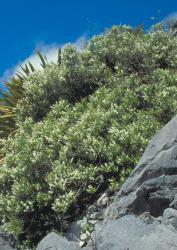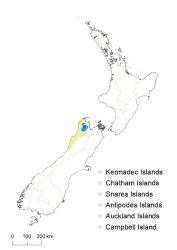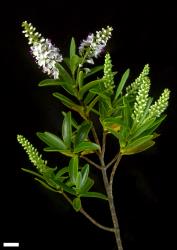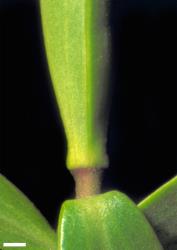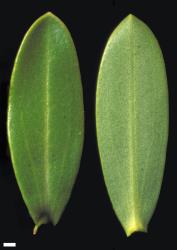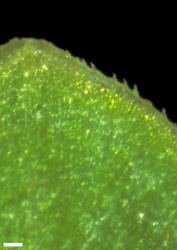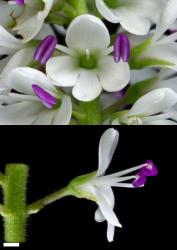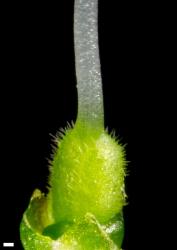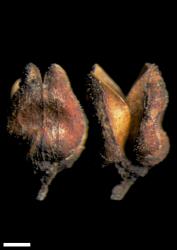- ≡ Hebe calcicola Bayly & Garn.-Jones in Bayly et al., New Zealand J. Bot. 39: 57 (2001)
Bushy shrub to 1.4 m tall. Stems spreading to ascending or erect, eglandular-pubescent or -puberulent; hairs bifarious to uniform. Leaf bud distinct, its outer leaves appressed at margins until fully grown; sinus absent. Leaves opposite-decussate, erecto-patent to spreading or recurved, lamina thin to sub-coriaceous, lanceolate, oblong-elliptic or oblanceolate, 13–45 mm long, 3.5–9.0 mm wide, glossy, dark green above, green beneath, midrib and two lateral veins evident; surfaces glabrous or with short, eglandular hairs along midrib above; margin ciliolate, especially towards apex, or glabrous, entire; apex sub-acute to obtuse, very weakly plicate-apiculate; base cuneate; petiole absent. Inflorescence a lateral raceme, 25–85 mm long; flowers crowded, 25–45, all bisexual; bracts alternate to loosely whorled, ovate to deltoid, < or rarely = pedicels; pedicels erecto-patent to spreading, 0.5–3.0 mm long, eglandular hairy all around. Calyx lobes 4, or small 5th posterior lobe sometimes present, obtuse to acute, 1.2–1.7 mm long, sub-equal, eglandular-ciliate with shorter glandular hairs and minute glandular hairs on surfaces. Corolla 5–7 mm diameter; tube white, 0.7–1.2 mm long, < calyx, eglandular- and glandular-hairy inside and on lower part of lobes above; lobes 4, white, erecto-patent to spreading or slightly recurved, sub-equal or unequal, ovate, elliptic, or obovate, 2.5–3.0 mm long, obtuse to rounded; nectar guides absent. Stamen filaments white, 3–5 mm long; anthers magenta. Style glabrous, 3.5–5.0 mm long. Capsules latiseptate, sub-acute, eglandular-hairy, 2.2–3.8 mm long, 1.5–3.3 mm at widest point. Seeds broadly ellipsoid, flattened, smooth, brown, 1.2–1.9 mm long.
V. calcicola plants resemble a number of other hebes that have glossy green leaves and no sinus in the bud, but a combination of characters is diagnostic: plants are cosexual (Bayly & Kellow 2006); flowers have short, wide corolla tubes; corolla lobes hairy near the base above but not on the margins; ovary and capsule hairy, but style glabrous.
V. subalpina plants differ in their always-glabrous leaf margins, longer corolla tubes, and glabrous ovaries and capsules.
V. rakaiensis plants have similar ciliolate leaf margins and short-tubed, small flowers, but differ in broader leaves, hairy styles at the base, and usually ciliate corolla lobes.
V. truncatula plants have similar hairs on leaf margins and similar leaf dimensions, but their leaves have a more prominent and minutely truncate apiculus, corolla tubes are longer, and their ovaries and capsules are glabrous.
V. traversii plants have flowers with a much longer corolla tube and capsules that are 3 to 4 times as long as the calyx.
South Island: Western Nelson (Peel, Lockett, Douglas, and Arthur Ranges and an unvouchered record from the Turk’s Cap Range).
Rock outcrops of Mt Arthur marble. Recorded elevations range from 820 to 1460 m.
V. calcicola is believed to hybridise with V. salicifolia and V. albicans, and this is supported by collections that are intermediate in morphology and flavonoid chemistry (Bayly et al. 2001).
Flowers: January–April; fruits: March–June.
2n = 80 (see Bayly & Kellow 2006, as Hebe calcicola).
Veronica calcicola is classified in V. subg. Pseudoveronica sect. Hebe and the informal group “Occlusae” (Albach & Meudt 2010; Bayly & Kellow 2006).



